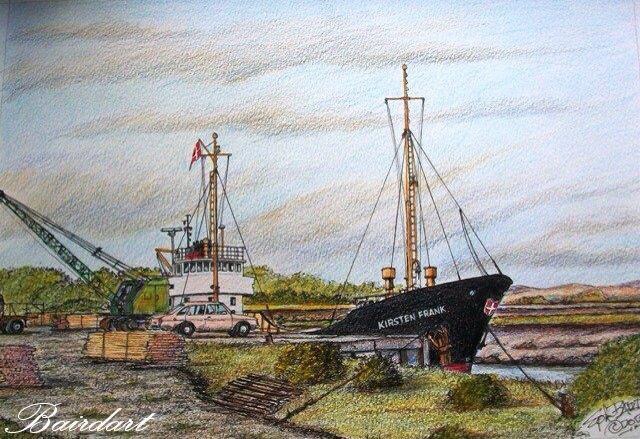
DURING the ‘Lockdown’ many people have discovered hidden gems they never knew existed within their two kilometre walking exclusion zones.
One such place is the Thorn Pier, four kilometres from the Market Square in Letterkenny, which is situated where the River Swilly opens into the Lough Swilly estuary.
It is difficult to picture now, that this overgrown area of trees at The Thorn was once a busy port which provided amongst other things coal, timber and salt to the ever expanding town of Letterkenny in the seventies and early eighties. On a few occasions the IAWS also imported fertilisers for use in the local agricultural community.
The coal was imported by Chas. Kelly & Sons and Tinney’s Coal Merchants while the timber, which came directly from Finland and Sweden, was used to roof many new homes and businesses in the surrounding areas. It was always great to see the hustle and bustle of any boat at The Thorn but it was usually the coal boat that caused most excitement as some of the locals would gather coal that would fall off the lorries.
Salt was also an imported product which came to The Thorn from Holland and Runcorn in Britain. The salt was used for curing fish in Killybegs and in the bacon factory in town.
Dating back to the mid 1800’s the first maps of the area show that there was a ‘Rock Quay’ located at the Thorn and it is thought that this quay was used for small boats to take passengers across the Swilly to link up with the Derry Road and onwards. Other such quays were located at Fort Stewart in Ardrumman and possibly one at Castle Grove just down stream from The Thorn.
In July 1932 the Thorn Pier was first mentioned in Dáil Éireann when Mr Neal Blaney (Fianna Fáil) asked Mr. Seán F. Lemass (Fianna Fáil), the then Minister for Industry & Commerce, “whether he had considered providing a proper pier at The Thorn, Letterkenny” to which Lemass replied that “an engineer had visited and inspected the site and he was awaiting his report” and that “enquires were being made as to the utilisation of the pier, if and when constructed.” Fifteen years later, a war of words ensued in the chamber when the topic of the pier was again raised by Mr. James Dillon TD, when Lemass was further questioned about progress at The Thorn. It seems that the Thorn Pier upgrade was put on the ‘long finger’ as the Government were looking at upgrading the pier at Rathmullan. Dillon raised a few eyebrows in Leinster House when he stated that “he recalled at a meeting in Letterkenny 15 years previous “that as soon as he (Lemass) was returned to power, repairs would be carried out at the pier adequate to admit transatlantic liners” to which Lemass replied: “I made no such declaration”
Historically the main port for the town of Letterkenny was located at the Port Bridge where the Polestar now stands but this port was only able to accept smaller boats due to the silt and tidal nature of the Swilly. As the size of the boats which came to Letterkenny increased in the 1970’s, it was soon discovered that the meandering and muddy river was unable to carry these vessels so far up stream and an alternative port was needed.
From local information it seems that during the 1960’s Chas. Kelly and Sons bought the land at the Thorn and set about upgrading the pier to allow larger 650-800 tonne coasters to dock there. During the following decade scores of boats made their way to The Thorn which were piloted by William Browne from Inch Island who boarded at Rathmullan and steered the vessels safely through the twists and turns of the tricky waters. In later years James Turner from Ardrumman acted as pilot.
As they say, history has a habit of repeating itself and sure enough it became unprofitable to take out-of-date coasters up the Swilly as larger ships were now needed and the docks at Lisahally in Derry served this purpose. The last coaster to dispatch at The Thorn was a ship owned by the Ramsey Steamship Company in the Isle of Man called The Ben Varey which steamed down the Swilly in the mid 1980’s which brought to an end Letterkenny’s nautical history.
While the shell of the pier is still intact the whole area has now become overgrown and the channel at The Thorn has changed course resulting in silting and accumulation of ‘glar’.
Really, all that remains are the memories of all those who worked at the pier or witnessed the boats slowly making their way to the Thorn.









